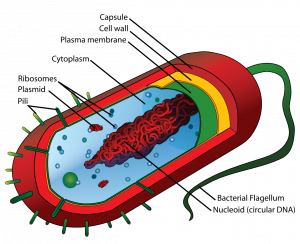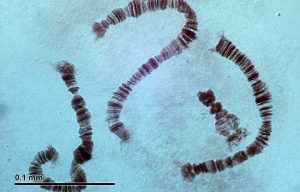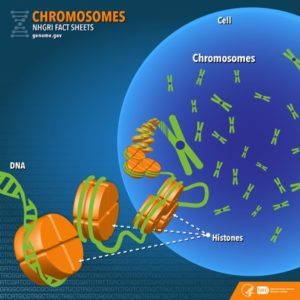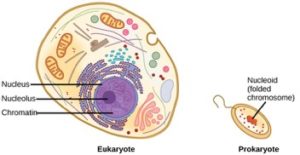67
DNA is a working molecule; it must be replicated (copied) when a cell is ready to divide, and it must be “read” to produce the molecules, such as proteins, to carry out the functions of the cell. For this reason, the DNA is protected and packaged in very specific ways. Because they must carry so much information, DNA molecules can be very long. Stretched end-to-end, the DNA molecules in a single human cell would come to a length of about 2 meters (roughly 6 feet). Thus, the DNA for a cell must be packaged in a very ordered way to fit and function within a structure (the cell) that is not visible to the naked eye.
A cell’s complete complement of DNA is called its genome. In prokaryotes (bacteria), the genome is composed of a single, double-stranded DNA molecule in the form of a loop or circle. The region in the cell containing this genetic material is called a nucleoid.Some prokaryotes also have smaller loops of DNA called plasmidsthat are not essential for normal growth.

The size of the genome in one of the most well-studied prokaryotes, Escherichia coli, is 4.6 million base pairs. This would extend a distance of about 1.6 mm if stretched out. Compare that to the length of an E. coli cell, which is approximately 1-2μm long. 1.6mm = 1600μm: so how does all this DNA fit inside a tiny cell? The DNA is twisted beyond the double helix in what is known as supercoiling. Some proteins are known to be involved in the supercoiling; other proteins and enzymes help in maintaining the supercoiled structure.
Eukaryotes, such as animals and plants, have chromosomesthat consist of linear DNA molecules. Chromosomes can be seen as thread-like structures located inside the nucleus of eukaryotic cells. Each chromosome is made of protein and a single linear double-helix of DNA (Figure 2). The term chromosome comes from the Greek words for color (chroma) and body (soma). Scientists gave this name to chromosomes because they are cell structures, or bodies, that are strongly stained by some colorful dyes used in research.

Eukaryotes typically have much more DNA than prokaryotes: the human genome is roughly 3 billionbase pairs while the E. coli genome is roughly 4 million.For this reason, eukaryotes employ a different type of packing strategy to fit their DNA inside the nucleus(Figure 4). At the most basic level, DNA is wrapped around proteins known as histones. The DNA wrapped around histones wraps and stacks through several additional levels of complexity. These thicker more compact structures are what you have seen before in pictures labeled “chromosomes”.

To summarize:
- Prokaryotes have relatively small amounts of DNA (millions of basepairs) found in one circular genome, which is located in the cytoplasm in the nucleoid.
- Eukaryotes have larger amounts of DNA (billions of basepairs) found in several linear chromosomes, which are located inside the nucleus.

References
Unless otherwise noted, images on this page are licensed under CC-BY 4.0 by OpenStax.
OpenStax, Concepts of Biology. OpenStax CNX. May 18, 2016 http://cnx.org/contents/s8Hh0oOc@9.10:8v2Xzdco@5/The-Structure-of-DNA
“Genetics Home Reference: Help Me Understand Genetics”by , National Institutes of Health: U.S> National Library of Medicineis in the Public Domain
